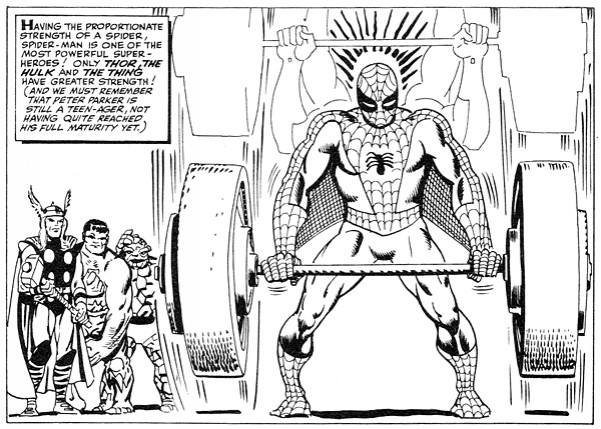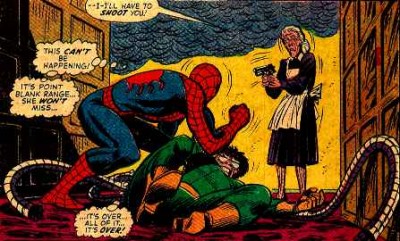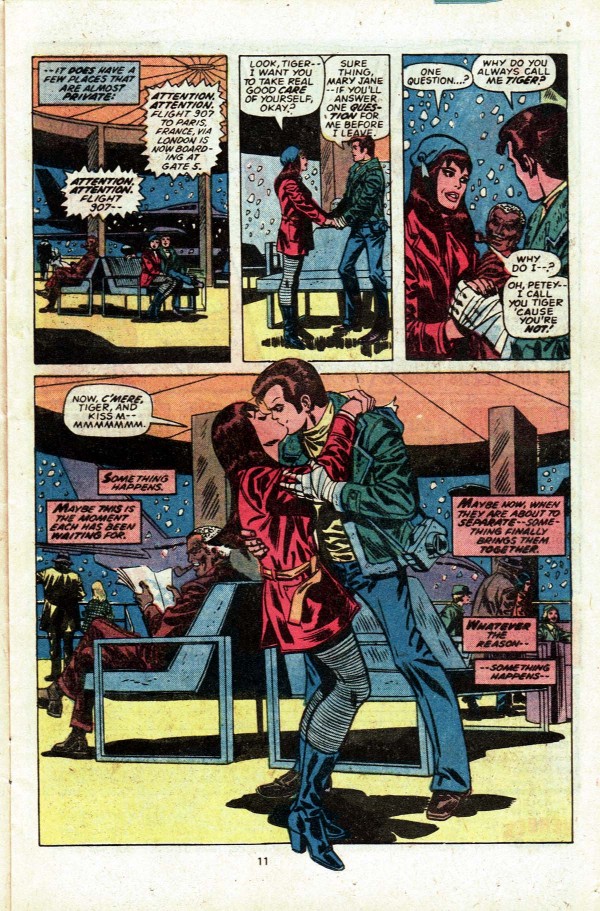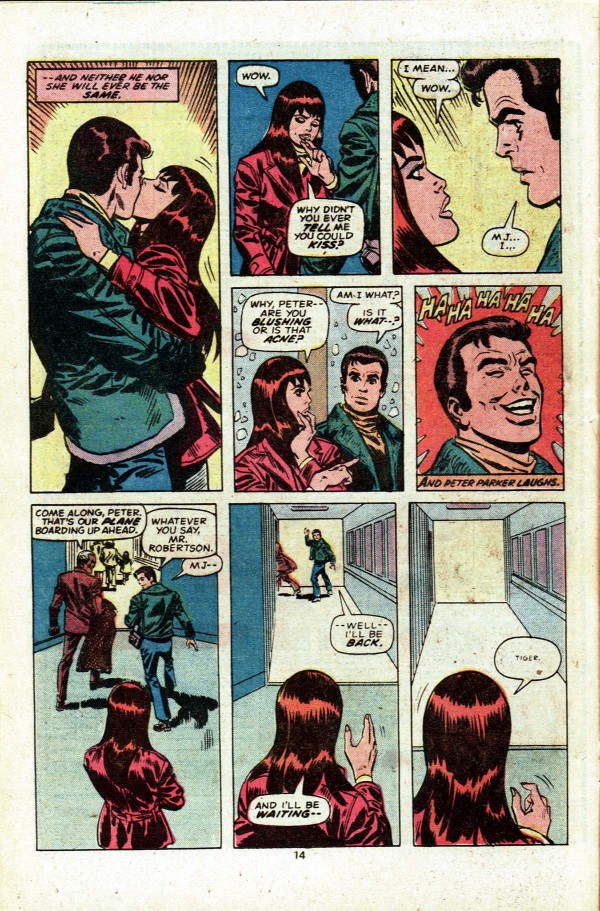
August 10, 2012
 Spider-Man At 50 Part One: A Few Thoughts On Amazing Spider-Man #1-150
Spider-Man At 50 Part One: A Few Thoughts On Amazing Spider-Man #1-150

 By Tom Spurgeon
By Tom Spurgeon
1. That initial run of
Amazing Spider-Man is one of the few
series in the pantheon of great comics, and the one that functions the most like we expect a comic book series to function. Unlike
MAD, or glory-years
Fantastic Four, or the first volume
Love and Rockets, that run of
Amazing Spider-Man gains strength from things that usually make series worse: creative-team changes, collaboration, commercial restrictions, the occasional very special episode. It's a miracle that they're as fun as they are.
2. I even like the fact that the run begins in another series entirely --
Amazing Fantasy -- and doesn't really end properly. There's something beautifully appropriate to that. You can pick a few endings from various moments after about issue #142, but I can't imagine there were too many fans that put the title down at that time and declared, "Well, that's over." It's only in retrospect that we can fashion an ending out of there, and then only of the "turns a modest but key corner" variety. It kept going. You can sort of see that there's no proper ending in how the movies have played out. You can end a Batman movie series because
Dark Knight made enough of an impression to make that seem possible. None of the proposed endings for
Spider-Man have really taken hold in a way that even suggests what to do in a movie; if they ever go that direction, it will seem really weird.
3. The odd thing about the lack of an ending is that the Spider-Man story explores an idea (the nature of responsibility) and boasts a narrative framework (a young guy growing up) that would
absolutely suggest an ending of some sort. I think it's the superhero stuff that gets in the way of that ever happening. One, it's hard for me to imagine someone taking full responsibility by being 48 years old and swinging around making wisecracks and punching Electro. Two, if you go the other direction, you have to sell fans that love the character as an underdog superhero, fans that love underdogs and really love superheroes, that becoming the fourth scientist on a team at Stark Labs or wherever (in fact, I seem to recall they did something like this once) and raising a couple of kids and being in love with his wife and coaching little league is a great thing rather than a terrible, depressing one.

4. I'm not all the way sure why the initial series holds together for as long as it did. I suspect it's a combination of a great character, a great hook, a bunch of talented pros and the intent that it remain all of a piece. Admittedly, you
can separate the Ditko issues, I think, into its own thing. The best argument for doing that is that the Ditko stuff is the most consistently inventive of all the Spider-Man material. It's the first reworking of the superhero formula where it seems like a smart person pulled things apart a bit and put them back together; it took the genre seriously. Ditko is a fascinating artist who pulled a lot of compelling ideas into those initial comics and presented them in a way that felt like he was totally committed to the characters and their narrative. It was a comic that respected its readers, which must of made it pop against the underlying disdain that seems just below the surface in the bigger DC efforts. I've always liked that when Peter Parker is mad at Flash Thompson in those early issues, he seems
super-freaking-mad, like it just
boils off of him. The urban milieu that crystallized at Marvel in the 1970s and remains a part of their books found first expression with Ditko. His body types are more interesting than everyone else's. He could be in the hall of fame simply for how he drew rooftops.
5. I personally find it hard to imagine Ditko's Spider-Man being sustainable as a narrative for more than a couple of more years after it concluded. The intensity of the character and the broader themes involved suggests a narrative that ends in death, which wouldn't have been possible.
6. I always think it's fun to read
Amazing Spider-Man as young Peter Parker's first forays into the adult world. The villains make up this seemingly unending wave of super-crappy adult role-models, some of which mirror Peter's life more directly than others. All three of Spider-Man's primary bad guys (Green Goblin, J. Jonah Jameson, Flash Thompson) are classic role-model types (father, boss, BMOC). The big shift to the Romita era, then, isn't just the romance-comic stylings and milieu shift but that Peter Parker actually has halfway decent role-models in two of those areas: Captain Stacy and Robbie Robertson.

7. It's pretty funny that classic-conception Spider-Man has three arch-villains, one for each part of his life. Pretty genius, too.
8. Before I noodle too much further, I always like to remind that most really good comics of the mainstream comics variety are that way because they have practical, executable elements that are well-done, pleasurable. In other words, they're written well (according to some reasonable standard, even if it's one that feels outdated now) and they're drawn in interesting fashion. I think for the most part that all of these Spider-Man comics qualify, the same way the Kirby
Fantastic Four material does. Spider-Man has more artists, but Ditko is a first-rate talent, John Romita is a top-notch illustrator and designer, and the Romita/Kane/Andru group is extremely talented and fully able to make super-handsome, well-staged comic books. I suspect we reduce comics in ruthless fashion to theme and concept because Stan Lee did this in order to present himself as an idea man within publishing and then later to Hollywood. Spider-Man has fine theme work, or at least the outlines of same, but if an appropriate concept were all that's necessary, one of the giant-man characters would be among the best comics of its era, and that's
never been the case.
9. That said, I do think there's an element of these comics working better in memory and in context than on the page in terms of providing a satisfying soap-opera narrative issue-in, issue-out. There were moments when everything's cooking -- that recent IDW Romita book reprinted as good a short run as this series had -- but there were also a lot of issues that when you read them feel like running in place, particularly the creators' ability to fold in some sort of physical, costumed conflict into the work. It can't be undersold how much reading mainstream comics in a certain era was projecting what you wanted them to be more than dealing with what they are.

10. Romita's run of covers is super-underrated as far as those things go. Strangely, outside of the iconic few that mark major story points, so is Ditko's.
11. Romita's staging is really great, too, both in his own work and in some of the changes he suggested for Gil Kane. You can quietly and almost immediately figure out where everyone is in relation to everyone else, and that positioning pushes the story along in a bunch of different ways. You really can't do effective soap opera over an extended period of time without good staging, because that's how you have your characters relate to one another on a visual level.

12. Aunt May is pretty much a hilarious turd of a character in these comics. This happens in modern mainstream comics a lot now, where the contempt for or disinterest in that creators and/or editors have concerning a character kind of settles onto the character -- you can see it a bunch of times over the last dozen years at Marvel. Aunt May might be the first character to suffer from this creative disdain -- in comic books, anyway. A lot of characters suffer this in comic strips, but they're generally written out of their features. I'm hard pressed to remember anyone from that era mentioning Aunt May without making a joke about Aunt May. This actually damages the character for later on, at least to my mind, in that admirable portrayals don't seem connected to the original -- they seem like admirable re-workings.
13. It's a good set of bad guys, famously so. I even like the low-level, goofy ones. I may especially like those, particularly Hammerhead and Man Mountain Marko. I never liked Lizard all that much, although the look is charming. In fact, the look suggests "alcoholic neighbor," which may be the way to understand him. The way I access that character right now is as a repeat of the scientist mirror character, a type better unpacked by Dr. Octopus. Most people have an alcoholic neighbor, and if you don't, you're probably that neighbor.

14. I'm not sure that Gwen Stacy and Harry Osborn work all that well as characters. They're both great, great visuals, though. Both Romita and Ditko were strong designers in terms of non-superhero characters, too.
15. I always thought it was interesting that Gerry Conway was as far as I could tell the only major writer for Spider-Man to write him when he was roughly the same age as Spider-Man. Conway's work strikes me as solid, and the clone storylines seem to me a super-creepy, clever way to talk about the loss part of taking responsibility. It's also, intentional or not, a great way to talk about the comics themselves and how fans process them. A little of that kind of thing goes a long, long way, but Spider-Man had been publishing for enough time at that point the book was able to handle what earlier on or more regularly employed might have become super self-indulgent.
16. So if the industry had gone under in the late 1970s, I wonder if Spider-Man would be remembered as the last important superhero. I wonder if you couldn't argue that anyway. There are only a few. Great character. These are really fun comics.
*****


*****
*****
posted 9:00 am PST |
Permalink
Daily Blog Archives
November 2019
October 2019
September 2019
August 2019
July 2019
Full Archives


